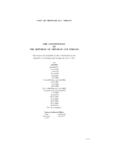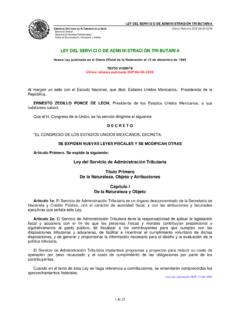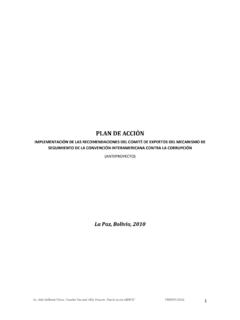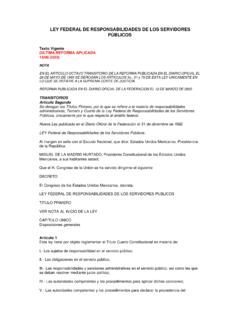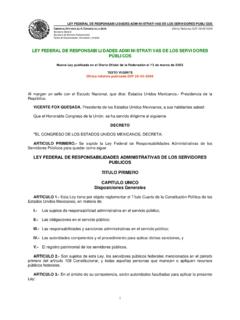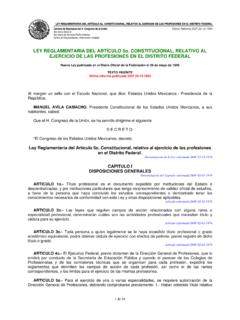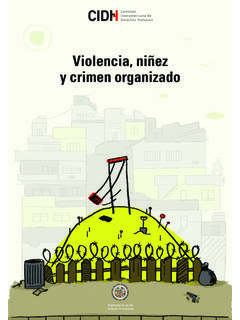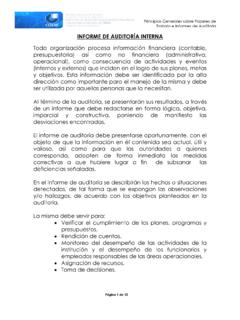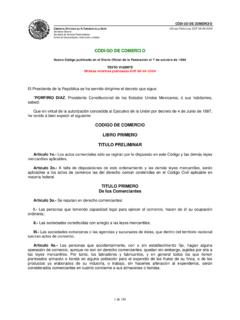Transcription of Trinidad and Tobago National Report
1 NATION AL REPOR T. ON. Integrating The Management of Watersheds and Coastal Areas in Trinidad and Tobago Prepared by The Water Resources Agency for The Ministry of the Environment Eric Williams Financial Complex Independence Square, Port of Spain March 2001. WRA/MIN. Env: Integrating the Management of Watersheds and Coastal Areas in Trinidad and Tobago i EXECUTIVE SUMMARY. The Republic of Trinidad and Tobago is an archipelagic state located at the southern end of the Caribbean island chain. The islands have a tropical wet climate of the monsoonal type. Rainfall that averages 2,200 millimetres, is seasonal with a wet season from June to November and a dry season from December to May. Temperatures range from 25 to 27 C, humidity ranges between 50 to 100% and wind speed averages between 20 and 28. km/hr. Trinidad 's landscape is characterised by steep mountains, undulating hills and plains. Tobago 's landscape is however, characterised by a highland area, which runs through the island and a small coastal plain.
2 The islands are endowed with extremely varied coastlines, a fair share of wetlands and richly diverse flora and fauna. The population is estimated at million with an annual growth rate of percent. Trinidad 's population is concentrated in urban areas along the west coastal areas and at the foothills of its northerly located mountain range. On the other hand, Tobago 's population is concentrated in the southwest part of the island. Relative to the rest of the Caribbean islands the country is highly industrialised with a petroleum based economy and a small but rapidly growing tourism industry concentrated mainly in Tobago . The Water Resources Agency has a rain gauge network of one hundred and ten (110) recording and non-recording rainfall gauges and a network of twenty-eight (28) streamflow stations, for the monitoring of the hydrological regime. These stations are well distributed over both islands but major deficiencies exist in relation to their upkeep and the quality of information provided.
3 The groundwater network in the twin island state boasts of one hundred and sixty-eight (168) production wells and one hundred and ten (110) observation wells. The Agency has recently completed the installation of a telemetry network consisting of eighty-one (81) sensors with the objective of providing automatic recording and transmission of hydrological and hydro-meteorological data from the river basin to the central office. Much still needs to be done by way of the quality control process before the telemetry system can have the desired impact on data provision and management nationally. Current water demand in Trinidad and Tobago amounts to 317 MCM/year while the water supply figure amounts to 273 MCM/year, representing a 44 MCM/year deficit. Investments over the last five (5) years to address the past and existing deficits amount to $US 431 million, including the imminent installation of a desalination plant at Point Lisas and the application of new technologies for locating and abstracting deep groundwater in bedrock aquifers.
4 Ironically, investments in water WRA/MIN. Env: Integrating the Management of Watersheds and Coastal Areas in Trinidad and Tobago ii resources management initiatives have been limited to just under $US million over a corresponding period. Much research and investigations are ongoing in the areas of Climate Change and Sea-Level rise. Trinidad and Tobago is a signatory to the Framework Convention on Climate Change (FCCC) which is directed towards achieving drastic reductions in the emissions of CO2 and other greenhouse gases. Flooding is the natural hazard of major concern to the population by virtue of its frequency of occurrence and the extent of damages resulting. This phenomenon is normally linked to poor watershed management practices and the unsavoury disposal habits of the population, particularly in urban areas. Pollution is a problem that is on the rise throughout the country. The main water pollutants are urban, domestic and industrial waste, solid and toxic agricultural products and waste, sediments, petrochemicals and oil spills form the oil and energy industries, waste from fishing vessels, ships, tourist facilities and yachts.
5 The pollutants affect both inland freshwater and coastal water resources, including the beaches and shores. The most serious threats to groundwater come from nitrate and bacterial contamination arising from agro-chemical use and sewage effluents from pit latrine soakaways and septic tanks. Another serious concern is saltwater intrusion as a result of overabstraction in coastal aquifers. There is no fully organised institutionalised public awareness and stakeholder participation programme in place for watershed/water resources and coastal zone management in Trinidad and Tobago . The key agencies have been involved in various initiatives targeting their spheres of interest. Such initiatives have generally not been sustained and have usually failed to recognise the integrated nature of the watershed and coastal zone sectors, essential for their success into the medium and long terms. There is no firm plan to enhance public awareness about watershed/water resource and coastal zone management and to involve community stakeholder participation.
6 This reflects the fragmented institutional framework and approach which currently exist in relation to the sector where efforts are uncoordinated and are unrelated to each other. Other key institutional issues include the need for closing the severe existing skills gap in several key competencies relating to watershed/water resources and coastal zone management through the provision of relevant training locally and abroad. The introduction of appropriate policies, legislation and master plans to govern and direct the respective sectors are seen as critical. Assistance with the provision of up-to-date equipment to facilitate the operations of the various agencies in the areas of WRA/MIN. Env: Integrating the Management of Watersheds and Coastal Areas in Trinidad and Tobago iii watershed/water resources and coastal zone management is another area which needs to be addressed. Like other countries, economic growth and development coupled with growth of the human population is resulting in environmental degradation of watersheds, water resources and coastal areas.
7 For Trinidad and Tobago , a twin island state, the coastal habitats and ecosystems assume significant importance. The coastal areas support a variety of life systems and valuable natural assets and within them are located key industries and economic activities. Similar to the watersheds, these areas are subjected to threats arising from a variety of land based activities. The country experiences much of the full range of environmental problems, from widespread pollution of its waterways and coastal areas, chemical spills, illegal dumping, deforestation, excessive soil erosion, fisheries and wildlife depletion. These problems are attributed to poor land use practices and an inadequate legal and institutional framework for watershed/water resources and coastal zone management. The watersheds and coastal areas are also under threat from natural disasters (tropical storms, earthquakes, floods and droughts) as well as climate change and sea level rise. The issues articulated above, present major challenges to the sustainability of a quality environment in the watersheds and coastal areas of Trinidad and Tobago .
8 A National management framework must therefore be formulated to deal with the pressures of increasing growth (in population, urban development and industrial activity), and the accompanying pressures on the environment. Such a framework must undoubtedly recognise the direct impacts, which emanates from their supporting systems (upstream watersheds and the marine environment). It must also explicitly recognise the trade-offs between development and environmental sustainability. To establish this framework the following group of actions is recommended: 1. Implementation of the concept of integrated resource management to attain sustainable development of the nation's watersheds and coastal areas. 2. Establishment of an effective financially autonomous institutional framework that facilitates proper water resources, watershed and coastal zone management. 3. Protection of the environmental quality and ecosystems of watersheds and coastal areas WRA/MIN. Env: Integrating the Management of Watersheds and Coastal Areas in Trinidad and Tobago iv 4.
9 Development of capacity and tools within a suitable institution to support the decision making process. ACKNOWLEDGEMENTS. The Water Resources Agency of the Water and Sewerage Authority and the Ministry of the Environment would like to thank Dr. Constantin Stere for his contribution on Coastal Zone Management and Integrating Watersheds and Coastal Areas and Ms. Judith Gobin for her contribution on marine and terrestrial ecosystems. Study support, guidance and technical contributions were also provided by the following staff of the Water Resources Agency: Dr. U. Maharaj Dr. S. Fletcher Mr. K. Meade Mr. W. Clement Credit must also be given to Judy Francis, Randolph Sankar, Nerisha Bachu, Sharon Archie, Giselle Rogers and Lynette De Coteau (typist). for their various contributions in the preparation of this Report . WRA/MIN. Env: Integrating the Management of Watersheds and Coastal Areas in Trinidad and Tobago v FOREWORD. It is recognized that Small Island Developing States (SIDS) of the Caribbean are very vulnerable to natural and anthropogenic interventions and climate change variability.
10 The resource limitations of SIDS make the sustainable management of these resources extremely important. In the Caribbean, freshwater supplies are frequently limited while coastal waters support living resources that are also limited. The increasing demands placed on these resources are likely to cause increasing conflicts over allocation and use in the foreseeable future. There is a definite need for the integration of freshwater and coastal water management to sustain and protect both freshwater supplies and coastal and marine aquatic resources. Trinidad and Tobago , the most southerly of the Caribbean chain of islands is located just off the South American main land. The island comprises one of the most diverse and productive ecosystems in the Caribbean with its tropical forests, fertile flood plains, swamps and abundant streams. The richness of its natural environment, unique blend of the world's major cultures, thriving industrial base and expanding population combine to present major challenges to the sustainability of a quality environment.
